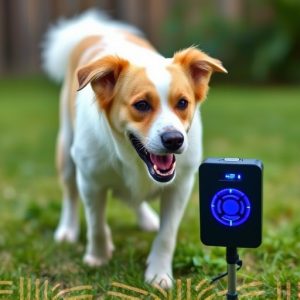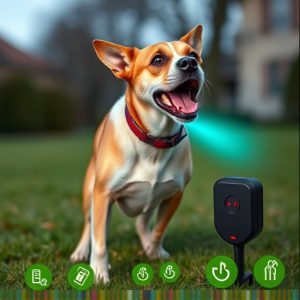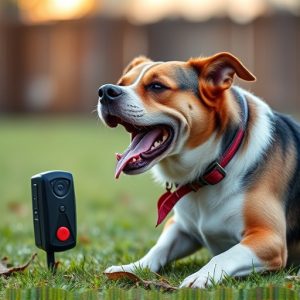Ultrasonic Dog Repellents: Effective Modes for Aggressive Pets
Dogs exhibit aggression driven by fear, anxiety, territoriality, or dominance. Ultrasonic technology…….
Dogs exhibit aggression driven by fear, anxiety, territoriality, or dominance. Ultrasonic technology offers a humane Dog Repellent Mode solution, using high-frequency sound waves (22-40 kHz) that are inaudible to humans but irritating to dogs, deterring unwanted behaviors like barking and aggression. Customizable modes include continuous ultrasound, motion-activated settings, and remote control options for targeted adjustments. These non-lethal devices provide effective solutions for aggressive pets, especially in homes with kids or other pets, though effectiveness varies among canines. Responsible use is crucial to avoid disturbance or habituation. Combining ultrasonic technology with other methods requires careful selection based on the device's capabilities and limitations.
In many urban settings, dealing with aggressive dog behavior poses a significant challenge. Understanding the root causes, such as territoriality or fear, is crucial before implementing solutions. One innovative approach gaining traction is ultrasonic technology in dog repellent devices. This article delves into this modern solution, exploring its inner workings, benefits, and drawbacks. We also provide practical tips on choosing the right dog repellent modes for aggressive pets, ensuring safety and effectiveness.
- Understanding Aggressive Dog Behavior: Causes and Concerns
- Introduction to Ultrasonic Technology for Dog Repellents
- How Does Ultrasonic Dog Repellent Work?
- Advantages and Disadvantages of Using Ultrasonic Devices
- Effective Dog Repellent Modes for Aggressive Pets
Understanding Aggressive Dog Behavior: Causes and Concerns
Dogs, like humans, have unique personalities and can exhibit aggressive behaviors for various reasons. Understanding these causes is essential when considering dog repellent methods. One common trigger is fear or anxiety; a dog may react aggressively to perceived threats or unfamiliar surroundings, often as a defense mechanism. This could be due to past traumatic experiences, lack of socialization, or even certain breed traits.
Another mode of aggressive behavior is territoriality, where dogs protect their spaces and resources, such as food, toys, or sleeping areas. Additionally, dominance-related aggression may occur when a dog feels it’s at the top of the pack, either within its own household or in interaction with other dogs. Identifying these triggers is crucial because different Dog Repellent Modes, like ultrasonic technology, can address specific behaviors. For instance, ultrasonic devices emit high-frequency sounds that are unpleasant to dogs, helping to deter territorial aggression by disrupting their focus on protecting their space.
Introduction to Ultrasonic Technology for Dog Repellents
Ultrasonic technology has emerged as a innovative solution in the realm of dog repellents, offering a non-invasive and humane approach to addressing aggressive pet behavior. Unlike traditional repellents that rely on strong odors or flavors, this technology employs high-frequency sound waves to deter dogs without causing harm. The device emits ultrasonic sounds beyond human hearing range but is perceptible to canines, creating an unpleasant sensation that encourages them to avoid certain areas.
This advanced method is particularly useful for addressing issues like territorial barking, unwanted aggression, and fear-driven behaviors. Dog Repellent Modes for Aggressive Pets can be tailored to specific situations, offering customizable settings to suit different environments and pet personalities. By adjusting the frequency and intensity levels, users can effectively train their dogs while promoting positive behavior modifications without resorting to unpleasant or potentially harmful methods.
How Does Ultrasonic Dog Repellent Work?
Ultrasonic dog repellents work by emitting high-frequency sound waves that are inaudible to humans but irritating to dogs. These sounds, typically ranging from 22 to 40 kHz, are designed to trigger an instinctive aversion response in the canine sense of hearing. When a dog detects these ultrasonic signals, it may feel discomfort, causing them to leave the area. The technology is especially useful for addressing aggressive pet behaviors, as it offers a non-lethal and humane approach.
Different dog repellent modes cater to various aggression issues. Some devices emit continuous ultrasound, creating an uncomfortable environment that discourages dogs from entering. Others feature motion-activated settings, where ultrasonic waves are triggered only when a dog approaches, allowing for targeted deterrence without disturbing other animals or humans nearby. Additionally, there are remote control options for precise adjustments in frequency and intensity based on the specific behaviors being addressed.
Advantages and Disadvantages of Using Ultrasonic Devices
Ultrasonic devices offer a unique and non-lethal approach to dog repellents, utilizing sound waves that are inaudible to humans but can deter canines. One of the primary advantages is their safety; they do not harm or cause pain to the animal, making them ideal for homes with kids or other pets. These devices often operate on multiple modes, allowing users to customize settings according to different situations and dog repellent needs. For instance, some models offer a sensitivity adjustment that detects movement and triggers ultrasonic signals only when necessary, conserving battery life. Additionally, they can be effective over large areas, providing peace of mind in gardens or outdoor spaces without the need for harmful chemicals or barriers.
However, despite their benefits, there are considerations to keep in mind. Ultrasonic devices might not work on all dogs, especially those with exceptional hearing or certain breeds known for their stubbornness. Some animals may become accustomed to the sound over time, requiring adjustments to settings or combinations with other methods. Moreover, while they are safe for humans, ultrasonic waves can potentially disturb neighbors or cause mild annoyance if not used responsibly. Therefore, choosing a reputable product and understanding its capabilities and limitations is crucial when considering ultrasonic technology for dog repellent modes in aggressive pets.
Effective Dog Repellent Modes for Aggressive Pets
For pet owners dealing with aggressive dogs, finding an effective dog repellent is paramount. In such cases, ultrasonic technology offers a unique and non-violent solution. This innovative approach employs high-frequency sound waves that are unpleasant to dogs but harmless to humans and other animals. By activating the device, it emits a range of ultrasonic tones, creating an invisible barrier that discourages dogs from entering specific areas.
The effectiveness lies in its ability to mimic natural sounds that trigger a dog’s innate aversion. Unlike traditional repellents, it doesn’t rely on strong chemicals or shock, making it ideal for managing aggressive behavior without causing distress. Dog Repellent Modes for Aggressive Pets can be further tailored with adjustable sensitivity settings and motion-activated triggers, ensuring the safety and comfort of both pets and owners while effectively deterring unwanted canine visitors.
When it comes to addressing aggressive dog behavior, ultrasonic technology offers a unique and innovative solution in the form of dog repellents. By understanding both the causes of such behavior and the science behind ultrasonic devices, pet owners can make informed decisions about which repellent modes are best suited for their furry friends. While these tools have proven effective, it’s essential to consider both the advantages and disadvantages before implementation. Ultimately, with proper usage, ultrasonic dog repellents provide a safe and non-harmful way to manage aggressive pets, ensuring peace of mind for both owners and those around them.


